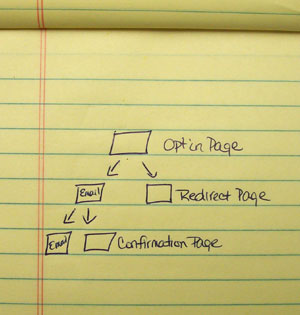
Each piece of content should work together to walk your visitor in and through the process, and each is an opportunity to make a positive impression and begin building a relationship.
Your goal is to turn your visitor into a loyal reader or a lifetime customer.
With that in mind, every piece of web content you create must have a clear objective. Knowing exactly what you want to accomplish - or what you want the reader to do - will help you create content in a specific order and with a clear purpose.
Let's start by looking at an obvious example:
This example is not your typical web content writing - it's about setting up a simple squeeze page to build an opt-in mailing list. It makes for a good example though, as there are a number of little pieces of content that go into that process.
You need content on the actual offer page, on the redirect page, the confirmation page, in the confirmation email and the follow up message, for the autoresponder series, etc:
That is, of course, my own simplified legal pad version of content mapping 😉
How you map out your web content writing plan is not as important as the fact that you do. It allows you to see each element of the process, and focus on the specific purpose for each of those individual elements.
Last week we talked about Improving the Customer Experience. I used the example of going out to dinner, and all of the elements that make up that experience - the atmosphere, the noise level, the service, quality of food.
But online, the elements of your visitors' experience are made up of various pieces of content.
Content is your biggest asset in an online business. It helps you rank well in the major search engines, get links from other websites, attract your target market, and convert those visitors into buyers or subscribers.
Good content keeps your list warm, keeps people opening your emails, or keeps people reading your blog - and it's also going to keep the search engines coming back and give you more and more exposure to new visitors in the search results.
Your content is ultimately what makes the sale.
When you get ready to write, consider your objective upfront. A lot of people will say that their objective is to write content so they'll get more traffic - you know, that whole thing about fresh content being "spider food" or attracting the search engine spiders?
Just getting traffic is fine if you have large advertisers that pay per impression, but for most of us traffic in general is completely pointless. Our real objective is conversions - whether that be to build our list, sell our products, or sell products as an affiliate.
So figure out your objective upfront - which means: know what you want your visitor to do when they visit your page, or after they've read your content. That way you can write in such a way that your web content leads into that specific call-to-action.
Now if you blog, and you're writing daily for your blog, every single post may not be written for selling. Sometimes your call-to-action can be as simple as asking your readers' thoughts and engaging them in a discussion through the comments section.
Or you might write a blog post or send an email to your list between promotions that is specifically for relationship building, or keeping that connection warm - and that's okay too. It's a necessary part of the process.
On the topic of web content writing, the question I get asked most is how to know what to write, and how to know what to publish where. Should this go on my blog, on my website, or should it be submitted to an article directory? Should I email this content to my subscribers, or put it on my blog and then email them a link to the blog post?
The answer to all of these questions lies in your objective, and in the specific purpose of each piece of content that you write. The best advice that I can offer is that you step back and get a birds-eye view of your business model. Look at it like a map - and look at each piece of content as a segment of that map.
- - - - - - - - - -
Find your ideal visitor. Connect with them where they are. Lead them in a specific direction. Communicate with them on their level at every step. Introduce your solution or offer. Answer their objections or concerns. Show them how or where to order. Follow-up with interest and support. Help them make the most of their purchase. Offer them additional resources or products to achieve their objective.
- - - - - - - - - -
That's just one simple example of a basic online selling process. Take a close look at your business model, and your overall objective, and consider ways you can improve on your process.
The best way to do that is to create a web content mindmap. It doesn't matter if you use mindmapping software, a whiteboard, or a plain old legal pad. Map out the content you need to write, and where it needs to be published, in what order... to achieve your specific objective.
Best,
p.s. Stay tuned as I have more web content writing tips in this series, including email newsletter ideas your subscribers will love, answers to common content writing questions... and an a-ha moment when I reveal my own purpose for writing this series - and the unexpected source where this series began.
Subscribe below so you don't miss a thing! 😉










Very good.
I love that! Writing with Purpose...
You nailed it Lynn, you should know your objective before hand. I think too often we start articles, posts and projects without every really knowing what the main goal is and what the proper steps are to get there. I know I have been guilty of that in the past.
Keep up the great work Lynn! 🙂
Terry, although I'm not trying to make $, I am trying to make meaningful connections.
I often wonder how to communicate my message effectively. In what order do I publish posts on a topic? Can I break them up? Where do I notify my readers and when about the upcoming post?
These steps will help.
Hi Lydia,
On notifying your readers, those who subscribe by RSS will receive the update immediately in their RSS reader. You can also set up email notification to go out every time you publish a new post, or at regular intervals like daily or weekly.
You can also use social media properties to promote your content. I usually tweet a link to the new post and put it in a Facebook update as well.
You can definitely break up topics into separate posts, like in a series for example. When you do this be sure to link to the next post, and link back to the previous post - that way new readers can find the earlier references, etc.
As for the order, simply publish in the order that makes the most sense for your readers.
Lynn,
Great blog post! Starting with a purpose is so important when creating online content. Mapping out your goal(s) on paper or via a mindmap really helps you see the flow and connect the dots when crafting a good piece of content.
Thanks so much Lynn. Gosh sometimes I feel like such a dork. It is almost like I lost all of my english writing skills. =) But of course I couldn't stand English.
I have a bad habit of starting an article in the middle. Even when I am out socializing I get blank stares because of this habit.
I know the objective planning will help me out.
Thanks for this great post.
I can relate, Dawnaurora - and the way I have tackled this monster is to use an outline format. This allows me to "start in the middle" or just write freely, but in an organized way. I then flesh it out and add in all of the other elements afterward. For an example of this see my outline for a blog post.
Yes, Content is biggest asset in an online business. I learned about actual offer page, redirect page, confirmation page. look forward to more tools, ideas, training and coaching from you.
I understand, but there will be no conversions if there is no traffic. I know, I can show you with my blog/site as a fine example!
Ahh - that's why we're now doing the link-building & SEO series 😉
I like what you mention when you say that you need to give different types of content that fit straight as a puzzle into each other. For exmple teaching someone blogging you will need to obviously tell him about the various things concerning it.
With havin so much content do you ever run into any issues of plagorism or copyright violation? My website has a lot of completely unique content I've either written myself or outsourced but it looks like a lot of it is popping it up all over the web without my permission. Do you know any ways to help reduce content from being stolen? I'd certainly appreciate it.